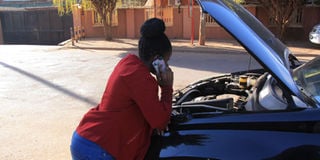Prime
What to do when your engine overheats

When you notice your car is overheating, first and foremost pull over to the side and turn off the engine.
What you need to know:
- When you notice your car is overheating, first and foremost pull over to the side and turn off the engine.
- If the engine is steaming viciously, do not open the hood. Wait for it to reduce.
- When you have opened the hood, check the coolant reservoir tank first. It is a plastic container that has a small hose running to the radiator.
Recently while stuck in traffic jam, I noticed a neatly dressed gentleman in a Toyota Rav4 that had steam mildly venting from the front area of his car. I wondered how he might have missed this. I signalled him making him aware of the issue. Now check this “oh yeah the temperature gauge is really high, so what do I do now?” he asked. Of course I just advised him to pull over and wait for the car to cool down, add water and find his way home or to a garage while watching the gauge and repeat the process if the temperature rises further. Of course there are a whole host of other issues that might cause overheating and require more dexterous techniques but this is always the first line of defence.
Overheating can be extremely bad for a car. See the inside of an engine is a sort of miniaturised furnaces for each cylinder, so the extreme temperatures need cooling. This is where the cooling system comes in. Back in the days of carburetors, when engines were made of steel, overheating was much more common, and less damaging. But the modern engine has far less tolerance, with its aluminium blocks and, often, aluminium heads.
Many head gaskets have been blown and engines cracked out by overheat issues and trust me these are not cheap repairs. The bill further rises up with the newer cars we are seeing now days. It is therefore extremely imperative that one maintains vigilance and watches that temperature gauge. Sometimes on really hot days or when the car is carrying heavy loads, the gauge might rise slightly above usual but eventually goes back.
Fixing an overheating problem depends on the complexity and the degree to which the temperature has shot up. If you only need to replace a fluid, it will take less than 10 minutes. If the problem cannot be easily understood and opinion of a mechanic is required, it can take a while longer even days to fix. Overheating can be caused by factors other than low coolant level including thermostat stuck, blocked radiator, malfunctioning fan, failed water pump or leakage. Sometimes it might be a failing temperature sensor. If the coolant level is not low, it is time to visit a mechanic.
Pull over
When you notice your car is overheating, first and foremost pull over to the side and turn off the engine. If the engine is steaming viciously, do not open the hood. Wait for it to reduce. When you have opened the hood, check the coolant reservoir tank first. It is a plastic container that has a small hose running to the radiator.
The reservoir can be filled when the engine is hot except when noted that you should not open when hot. Then open the radiator cap with a wet rag. Remember if you open the cap while it is still warm, you may burn yourself with steam or hot coolant. Check the upper and lower radiator hoses, or any of the heater hoses for any leakages.
Cool the engine
Restart the engine and obsessively watch the temperature gauge. If it is a coolant leakage repeat the above every time the gauge is in close proximity to the red. Understand that you can continue driving a high-temperature car if you’re far from a phone or a service station and issue isn’t leaking coolant or does not respond to the above.
However, drive only as long as you stop and turn off the engine whenever the gauge gets close to the red, and let the engine cool down until you drive again. This may take a long time, but it probably beats walking. Remember that the car cooling system is a closed one so losing coolant simply means a leakage that needs fixing.




